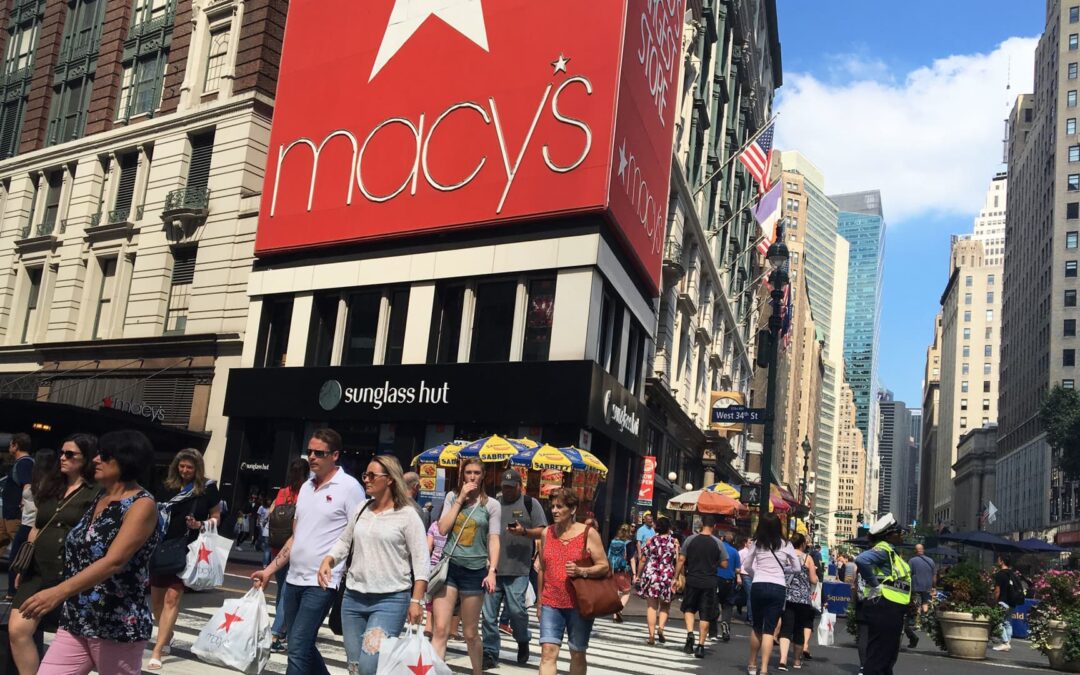Macy’s store in Herald Square in New York.
Scott Mlyn | CNBC
Macy’s on Tuesday topped Wall Street’s quarterly sales expectations, even as it struck a cautious note about consumer spending for the back half of the year.
The department store operator stood by its conservative full-year guidance as sales sag. It said it expects comparable owned-plus-licensed sales to fall 6% to 7.5% compared with the prior year. It anticipates adjusted earnings per share will range from $2.70 to $3.20, and sales will be between $22.8 billion and $23.2 billion for the fiscal year.
The retailer cut the forecast in early June.
In a CNBC interview, CEO Jeff Gennette said “the consumer continues to be under pressure.” The company has seen rising credit card balances in its own card data, he said. Plus, he said, people are spending on experiences and preparing for the return of student loan payments this fall.
But he Gennette that the company is focused on having the items consumers are still willing to buy, such as fragrances and other beauty products. UnderArmour and Nike merchandise are also returning to Macy’s after several years of being missing from its shelves.
“We’re moving into areas of interest,” he said. “We’re pulling back on categories that aren’t working. So we’re ready for the back half [of the year] to respond to the consumer where and when they shop.”
Here’s how the retailer did for the fiscal second quarter that ended July 29 compared with what Wall Street expected, based on a survey of analysts by Refinitiv:
- Earnings per share: 26 cents adjusted vs. 13 cents expected
- Revenue: $5.13 billion vs. $5.09 billion expected
The company swung to a net loss of $22 million, or 8 cents per share, from a net income of $275 million, or 99 cents per share a year earlier.
Net sales fell from $5.6 billion a year earlier.
Comparable sales on an owned plus licensed basis dropped 7.3%, a little worse than the 6.48% decline that analysts expected, according to Refinitiv.
As a retailer that sells a lot of clothing and accessories, Macy’s has taken a deeper hit from a consumer pullback than those that sell staples. When the department store operator cut its full-year forecast early in the summer, it said it had seen sales weaken in the spring, even at its higher-end chains, Bloomingdale’s and beauty chain Bluemercury.
Those sales patterns largely stayed the same in recent months, Gennette said. July was a strong month compared to the rest of the quarter, but consumers’ purchases were “very value driven,” he said.
Macy’s namesake stores and website put up the weakest sales in the quarter. The chain’s comparable sales fell 8.2% on an owned plus licensed basis, but bright spots included fragrances, prestige cosmetics and men’s tailored apparel.
At upscale department store Bloomingdale’s, comparable sales dropped 2.6% on an owned plus licensed basis as shoppers bought beauty items, women’s contemporary and designer apparel and shoes. Sales of handbags, men’s apparel and dresses were softer in the quarter, the company said.
Its beauty chain, Bluemercury, stood apart with year-over-year sales gains. Comparable sales rose 5.8% on an owned basis, as shoppers bought skincare items and color cosmetics.
Gennette added that the company has cleared through spring merchandise through markdowns and has stocked up on the fresh items for the fall and holiday season. Inventory was down 10% year over year and down 18% compared with 2019.
Shares of Macy’s closed Monday at $14.73, bringing the company’s market value to $4.01 billion. It has underperformed the market so far this year, as its stock has fallen 28% as the S&P 500 has climbed nearly 15% during the same period.
This story is developing. Please check back for updates.









